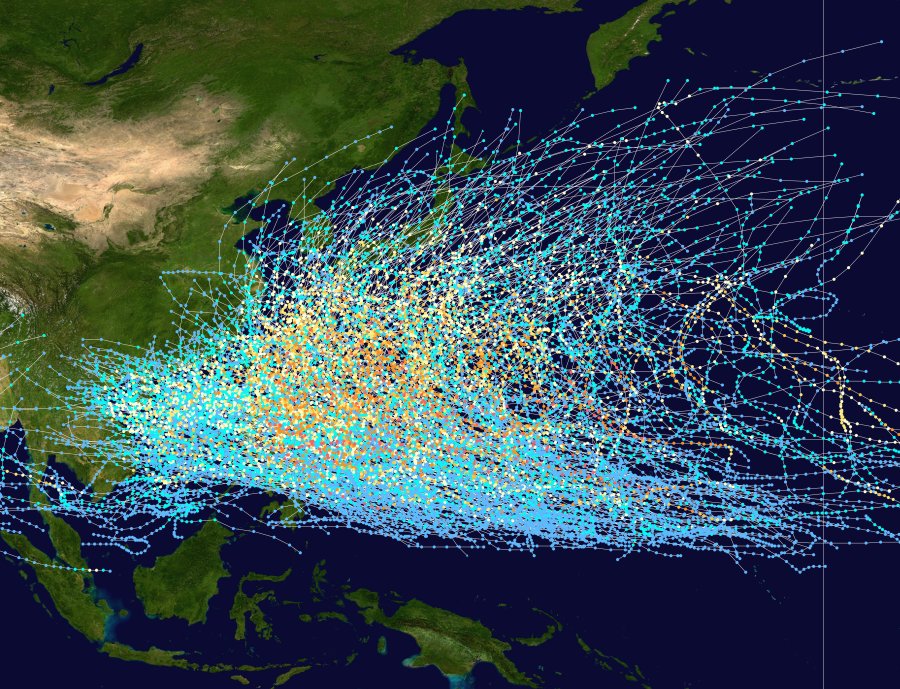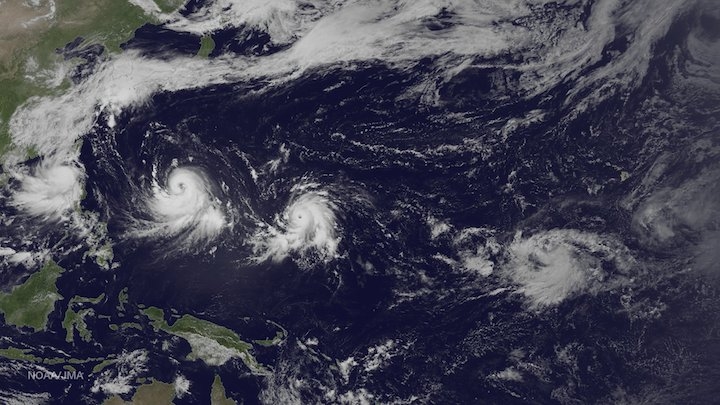New Study: Climate Change Has Doubled the Number of Category 4 and 5 Storms Striking East and Southeast Asia
6
September, 2016
The
atmospheric-ocean heat engine. It’s a pretty simple mechanism for
pumping up the power of storms. But as simple as it is, the
results can be devastating when this engine gets revved up by
human-forced climate change,
according to a new study released Monday in Nature
Geoscience.
The
Heat Engine in Action
As
the ocean surface warms, it heats the local atmosphere. This
generates an updraft that pushes higher and higher into the air
above. Heat also causes water at the ocean surface to evaporate. This
evaporated water is borne up on the winds and air currents rising
above the heating water. A low-pressure system forms and the water
vapor condenses into clouds which ultimately become
thunderstorms. The
Coriolis effect gives
it all a nudge and the storms and clouds start to pin…
(Pacific
Ocean typhoon paths from 1980 through 2005. A new study shows that
the destructive power of landfalling typhoons in East and Southeast
Asia has increased by nearly 50 percent since 1977. Meanwhile, the
number of category 4 and 5 storms striking land has doubled. All
impacts due to ocean-surface warming related to human-caused climate
change. Image source: Commons.)
The
process described above happens every day at the ocean surface.
Sometimes these storms form into the powerful cyclones we call
hurricanes and typhoons. Under normal global temperature conditions,
the kinds and intensities of these storms are what we have generally
come to expect. But if you add heat to the Earth System, as we do
when we burn fossil fuels and dump carbon into the atmosphere, the
whole storm formation process gets amped up — and produces the
powerful outlier storms that have become more common over recent
years.
Add
Human-Forced Warming and End up With More Powerful Storms
The
fact that such added heat tends to generate more powerful storms has
been a generally accepted part of our understanding of climate
science for some time now. However, it was not until recently that
this signal of rising storm intensity became visible in the science.
Now, a
new study published today in Nature
Geoscience indicates
that’s exactly what’s happening in parts of the Western Pacific.
It’s
a pretty earth-shattering revelation with multiple climate
change-related findings which
are worth reading about in full here.
These findings boil down to the following:
- The number of category 4 and 5 storms striking southeast Asia has doubled since 1977.
- The overall destructive power of storms striking this region has increased by nearly 50 percent over the same period.
- This increase in powerful storms has been caused by ocean warming related to climate change.
Standing
alone, any one of these findings would be significant. Taken
together, they paint a picture of significantly rising risk of storm
damage and related loss of life due to climate change in one of the
world’s most highly populated regions. In other words, the storms
firing and running in to land in this region are not the same as they
once were. They have been dramatically altered by the massive volume
of greenhouse gasses hitting the world’s atmosphere due to
fossil-fuel burning, accumulating over the decades.
The
study notes that:
Here, we apply analysis to corrected data and show that, over the past 37 years, typhoons that strike East and Southeast Asia have intensified by 12 to 15 percent… a nearly 50 percent increase in instantaneous destructiveness… with the proportion of category 4 and 5 storms doubling or even tripling… We find that increasing intensity of landfalling typhoons is due to strengthened intensification rates which are, in turn, tied to locally enhanced surface warming on the rim of East and Southeast Asia.
Ramping
Storm Intensity
This
scientific study helps validate and clarify what many weather and
climate observers have already noted during recent years. The
destructiveness of storms striking land in East and Southeast Asia is
not normal. And, land-falling category 4 and 5 storms are
occurring with greater frequency over broader regions.
(Four
Pacific typhoons take aim on Southeast Asia during July of 2015. A
new study finds that the landfall intensity of storms like these is
increasing due to human-caused climate change. Image source: NOAA.)
The
Western Pacific basin is now capable of producing storms like
Haiyan, whose
destructive intensity at landfall was mostly theoretical decades
before. This increase in intensity has been observed during a period
of rapid Earth warming. And with more warming in store, the storms
are likely to grow even more intense. From the Nature
Geoscience study:
The projected ocean surface warming pattern under increased greenhouse gas forcing suggests that typhoons striking eastern mainland China, Taiwan, Korea, and Japan will intensify further. Given disproportionate damages by intense typhoons, this represents a heightened threat to people and properties in the region.
Links:
Intensification
of landfalling typhoons over the northwest Pacific since the late
1970s,
Wei, M. and Xie, S.





No comments:
Post a Comment
Note: only a member of this blog may post a comment.